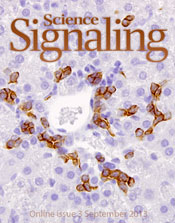- ホーム
- AngiomotinによるYAPの核への移動が細胞増殖および発がんに関与
AngiomotinによるYAPの核への移動が細胞増殖および発がんに関与
Angiomotin’g YAP into the Nucleus for Cell Proliferation and Cancer Development

Sci. Signal., 3 September 2013
Vol. 6, Issue 291, p. pe27
[DOI: 10.1126/scisignal.2004573]
Wanjin Hong*
Institute of Molecular and Cell Biology, Singapore; Department of Biochemistry, Yong Loo Lin School of Medicine, National University of Singapore, Singapore; School of Pharmaceutical Sciences, Xiamen University, Fujian, China.
* Corresponding author. E-mail: mcbhwj@imcb.a-star.edu.sg
要約
Hippo経路は、発生、組織の再生および発がん中の細胞増殖およびアポトーシスを調節する。転写因子Yes結合タンパク質(YAP)およびPDZ結合モチーフを有する転写コアクチベーター(TAZ)の核転座およびその後のYAPおよびTAZとTEAドメイン(TEAD)転写因子との相互作用が増殖促進性、抗アポトーシス性転写をプログラミングしている。足場タンパク質angiomotin(Amot)およびangiomotin関連AmotL1およびAmotL2がYAPおよびTAZの核転座を阻害することによって、それらの負の調節因子として働いていることが最近明らかになった。一方、Science Signalingの本号においてYiらは、AmotがYAPの核転座を促進し、組織の損傷に対してまたは腫瘍抑制因子Merlin非存在下で、YAP-TEAD複合体の転写補因子として胆管上皮細胞の増殖を促す作用をもつ可能性があることを明らかにした。これらの一見矛盾する結果は、Hippo経路におけるAmotタンパク質に関する理解がまだ限られていることを浮き彫りにしている。
W. Hong, Angiomotin'g YAP into the Nucleus for Cell Proliferation and Cancer Development. Sci. Signal. 6, pe27 (2013).
2013年9月3日号






